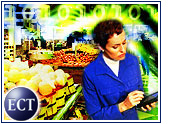
Pop quiz: How many of the 10 most populous U.S. cities, according to the U.S. Census Bureau, have a national online grocer at their disposal that will deliver both perishables and non-perishables?
The answer is five: New York, Los Angeles, Chicago, Houston and San Diego (*correction).
The fifth and sixth most populous cities, Philadelphia and Phoenix, appear to be out of luck. Additionally, even online grocery service in the five cities that are served is typically limited to narrow areas, such as Northern San Diego or select segments of greater Los Angeles.
These holes in the fabric of online grocery delivery are partially the result of acquisitions and closures that have eliminated names like Webvan, HomeGrocer.com and HomeRuns.com from the industry.
If you live in an area where online grocery service has been canceled — or where it never arrived in the first place — you might need to be more patient than ever. In the new age of online delivery, Net grocery providers have become extremely cautious not only about what cities they will venture into, but even which neighborhoods within a given city they will try.
The New Model
At first glance, the mishmash of cities currently being served by the online grocery market might appear to be the random result of the general chaos that has struck the industry. Take a closer look, however, and a certain pattern emerges.
Why can shoppers in Fairfield County, Connecticut order their milk and bread online, while folks in Dallas have to grocery shop the “old school” way? Why do people in Boston, Washington, D.C. and Seattle get the online grocery privilege, while consumers in larger cities, such as San Antonio, Detroit and Phoenix, have to drive to the supermarket?
“It’s not a matter of major city versus non-major city,” Gartner analyst Kevin Murphy told the E-Commerce Times. “The model that’s proven to work is where an existing grocery chain with a strong presence in the market develops its own online ordering system and uses its own stores as the warehouse.”
Going Upscale
At the same time, even having a strong brick chain such as Safeway (NYSE: SWY) or Albertson’s (NYSE: ABS) in your area might not be enough to help you click your way through the aisles.
“We tend to still be thinking of online groceries in a mass market approach, but you can’t look at it that way,” Murphy said. “The demand is much spottier than that. It will be tested and rolled out store by store, by chains that have the best collection of stores in upscale neighborhoods.”
In other words, there is a very good reason why folks in Fairfield County can get online groceries while other major metropolitan areas cannot. According to Murphy, Fairfield is one of the highest income counties in the country.
In the Lab
Murphy said that the future business model for online grocers will look very much like the Fairfield County model that Royal Ahold (NYSE: AHO) — now in the process of buying all outstanding shares of Peapod (Nasdaq: PPOD) — has in the works.
Ahold has linked Peapod with Stop-N-Shop, Ahold’s local Fairfield chain. The plan then calls for Stop-N-Shop to assign a few online delivery trucks to one of its most upscale area stores.
If the online deliveries get enough business in the area, Stop-N-Shop can build a warehouse there, add more trucks, and expand. If not, Royal Ahold can move on to try a new area. The approach provides a low-cost way of experimentation.
Taking Aim
Although it appears that online grocers are simply catering to the rich, at its core, the neighborhood-by-neighborhood approach illustrates fundamental marketing techniques, according to Murphy.
“It’s a lot more targeted approach if you can do it store by store, rather than building an entire warehouse up front,” Murphy said.
In this case, the targets are those neighborhoods where consumers are particularly starved for time and price sensitivity is not an issue, according to Murphy.
UK grocer Tesco was the company that “cracked the code,” Murphy said, by discovering that if it rolled out small, by sending just two trucks to the right store, its online operation could be profitable.
The scaled-back business model might be great news for the Internet grocery industry, but it is bad news for all but a select group of potential online grocery shoppers.![]()
*Editor’s Correction Note: In the original version of this article, we reported that the city of Houston was no longer serviced by any online grocery companies. In fact, GroceryDrop.com makes deliveries of groceries in Houston.

















































The problem with all of the existing models of home delivery of groceries is the business model is WRONG!!!
Although I have been a voice in the wilderness as it pertains to this subject, I know why everything has failed to date.
Webvan came the closest to the correct business model, but got bogged down in the system–they created “A Field of Dreams” and lost sight of the true needs of the business.
Home delivery of groceries requires a change in consumer shopping behavior. State of the art distribution systems doesn’t address this. Nor will the “limited” area delivery, as used by Ahold and others.
A recent Kiplinger letter discussed home delivery of groceries and they determined that a need continues to exist. Unfortunately, previous attempts by the likes of Webvan, Peapod, HomeGrocer.com, etc. didn’t satisfy that need.
Traditional grocers will view home delivery as an add on business, never a stand alone business. They have billions of dollars invested in the existing business model, and have no desire to go into competion with themselves.
Unfortunately, Wall Street raised far too much capital on faulty business models. Wall Street became enamoured with names of individuals, e.g. Lou Borders, or highly automated systems, and they didn’t do their homework.
…The result–no capital will be raised in order to make this concept the roaring success that it can be if done properly, and it will be a long time,if ever, that home delivery of groceries will be available to all, including those most in need (hint:it isn’t the wealthy–check the number of taxis going to grocery stores and waiting)
Who is the online grocer in San Diego?
There is actually online grocery delivery available in Houston through GroceryDrop.com